Pilates is hot. More than 12 million Americans — a 605 percent increase since 2001 — are now practicing this mind-body exercise that involves a series of movements, which, with names like the Corkscrew and the Mermaid, can look and sound funny to the first-timer.
Why the sudden popularity boost? Because Pilates works.
“People always complain that their bottoms are flabby, their waistlines are sagging, their lower abdominals are pooching,” says Brooke Siler, owner of re:ABPilates, a renowned New York City studio, and the author of The Pilates Body and Your Ultimate Pilates Body Challenge. “Pilates targets all of these areas and more.”
Named for its founder, Joseph Pilates, this intense, whole-body workout methodology addresses the three core tenets of fitness: cardiovascular training, strength training and flexibility. While it may not get your heart pumping like the treadmill, it does leave you feeling sweaty, refreshed, inspired — and many say, taller.
Pilates exercises can be performed on a sticky mat or a machine called a reformer (essentially, a padded platform with springs and pulleys). The type of Pilates class or practice you choose depends mostly on your personal preference. Kevin A. Bowen, cofounder and executive director of the nonprofit Pilates Method Alliance, estimates that about half of Pilates practitioners use a reformer; the others use a mat.
For safety and efficacy, reformer classes are usually small-group affairs with about six students per instructor. The added attention from the instructor improves your skills and intensifies the workout. Mat work, on the other hand, tends to be less expensive and much more portable. As with yoga, you can roll out your mat in the den, in a hotel room or even on the beach. Some workouts incorporate both reformer and mat exercises.
Central Attraction
Pilates draws so many followers because of its myriad physical and mental benefits. Exercises such as the Hundred (one of four classic moves that Siler shares, next page) target the powerhouse: the midsection abdominal muscles that are the basis for just about every action your body takes. The Hundred is different from traditional abdominal crunches, which hit just the upper, superficial abdominal muscles. “We teach that everything initiates from the powerhouse,” says Siler. “We focus on pulling the navel in and up toward the spine and working oppositionally. Plus, you’re lengthening through your joints so there’s never any compression.” The net result: Everyday tasks (such as loading groceries and picking up kids) become easier, and your entire midsection looks leaner and more toned.
Pilates is famed for lengthening and strengthening muscles without building bulk, while also improving posture and alignment. The body is like a car, says Lauri Stricker, a Colorado-based instructor and author of the forthcoming Pilates for the Outdoor Athlete. “You tune it up, you change your oil, you replace all the fluids — but if it’s misaligned, parts are going to wear out, and damage is going to be done. Alignment is the first principle of good movement, and improving the quality of your movement is one of the biggest things you can do to improve your quality of life.”
Bonus Benefits
Stricker notes that good posture can help you breathe better, improve your digestion and prevent headaches. Better alignment and posture also help individuals recover faster from injuries — and prevent them from happening in the first place. Craig Zeller, a financial adviser from Denver, Colo., discovered Pilates by accident — literally. After he tore both of his rotator cuffs kayaking, his physical therapist prescribed Pilates. The practice aided his recovery, he says, and improved his paddling form. “With better core awareness and balance, I find myself much less susceptible to over-tweaking my arm muscles,” says Zeller, 51.
Many athletes, including Ironman champion Paula Newby-Fraser and Nordic skier Johnny Spillane, have been inspired to take up Pilates as a form of cross-training, not only for its physical benefits, but also for the mental boons (including relaxation, body awareness and concentration) that the exercise affords. Each movement incorporates visual images and cues — such as slapping water or reaching for imaginary objects — that demand concentration. This not only makes the hour or so of class time fly by, it also tends to leave your mind clear and focused, your spirits lifted.
Curious to find out what Pilates can do for you? Try the exercises presented here. Then sign up for a class. Chances are, you’ll discover muscles you never knew you had.
The Hundred
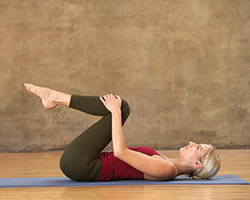
1) Lying on your back with knees pulled into your chest, inhale deeply, and as you exhale, sink your chest and belly into the mat.
2) Folding forward from your upper back — not your neck — raise your head toward your belly and stretch your arms long by your sides, reaching forward until you feel the bottom of your shoulder blades sinking into the mat. Straighten your legs to the ceiling and begin pumping your arms straight up and down as if you’re slapping water, inhaling for five counts and exhaling for five counts.

3) Lower your legs to a 45-degree angle, or to the point just before your back arches away from the mat, and continue pumping your arms. Breathe for a total of 100 counts.
Power Point: Squeeze your buttocks and the backs of your upper inner thighs together until no light comes through them; this will help stabilize your lower back. Keep your shoulders pressed away from your ears, which will stretch the neck and increase the abdominal focus.
The Tree

1) Sitting tall with one leg outstretched on the mat and the other bent toward your chest, support your bent leg with layered hands on the back of your thigh. Engage your powerhouse and inhale as you straighten your bent leg toward the ceiling; exhale as you bend it again. Repeat three times, growing taller with each movement.
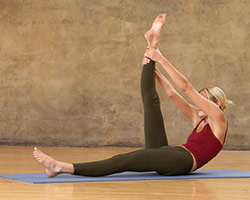
2) On your last lift, leave your leg up, and walk your hands toward your ankle, lifting in your waist as if cinched in a corset and bringing your chin to your chest. “Scooping out” your abdominals, slowly lean back until the back of your pelvis is touching the mat and your leg is reaching toward the ceiling.

3) Walk your hands down your leg as you press your spine into the mat, vertebra by vertebra. Reverse the movement, and walk your hands back up your leg (avoid pulling); after five repetitions, switch legs.
Power Point: Imagine your leg is an oak tree you are climbing. This will help lengthen and strengthen your abs and lower back, and also tone your arms.
Small Sidekick Circles

1) Lying on your side with your elbow, shoulder, midback and buttocks aligned with the back edge of your mat, position your legs at a slight angle in front of your body (from nearly straight to 45 degrees) for stability.
2) Slightly turn your top leg outward at the hip and thigh, which releases your quadriceps and allows you to work from your hips and buttocks more efficiently. Keep your top foot long and aligned with your hip, just above your bottom heel. Begin circling the leg from the hip in a small but vigorous forward motion. Complete five circles forward and then reverse for five circles.
Power Point: Pretend you are holding a hot cup of coffee on your shoulder, which will stabilize your upper body and lead to better results on your upper and inner thighs — so will imagining that you are circling your leg inside a small hoop.
The Saw

1) Sitting up as tall as possible, with your legs extended slightly wider than hip-width apart, stretch your arms as long as possible out to your sides. Inhale, drawing in your powerhouse as you twist from your waist to your right. Keep the bones of your bottom planted flat on the mat.
2) Exhale as you pivot your head and chest down toward your right knee, reaching your left hand past your baby toe, deepening your exhalation by pulling in your belly in opposition to your reaching hands. Then inhale and slowly draw your body upward into the starting position, lifting the crown of your head up. Repeat the sequence to the left. Complete four sets.
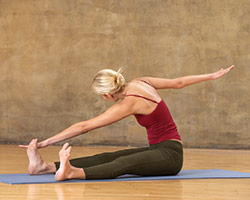
Power Point: In between reaches, stretch your arms out as if you were trying to touch both sides of the room at once. Throughout the movement, pretend your legs are stuck in cement and that you are trying to saw off your baby toe. This will lead to a better upper-body and waistline stretch.
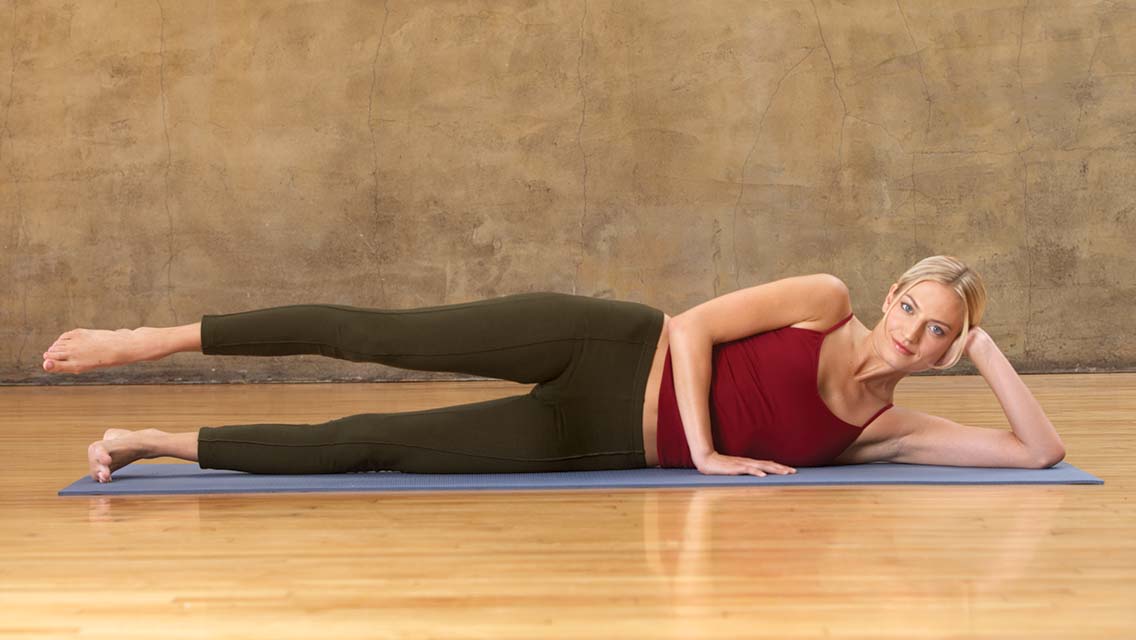
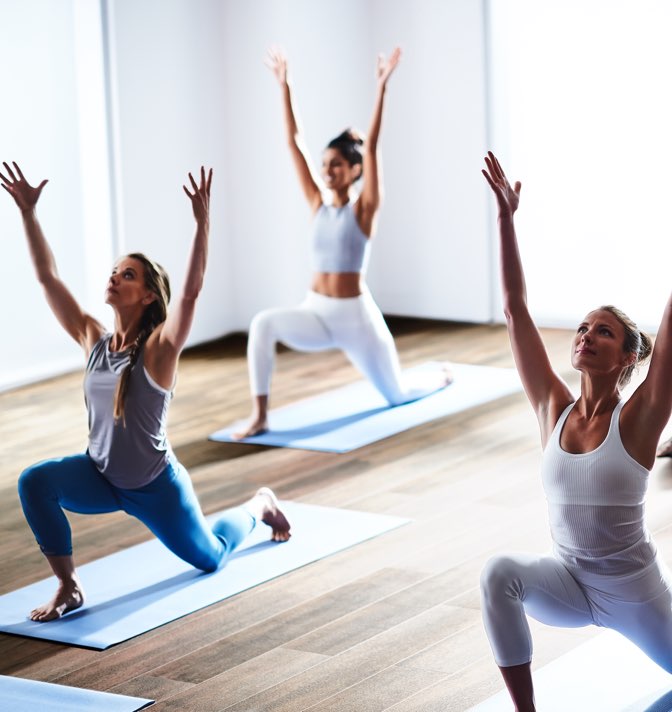


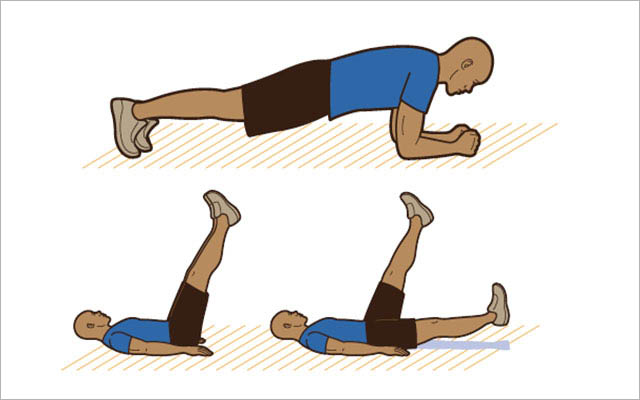
This Post Has 0 Comments